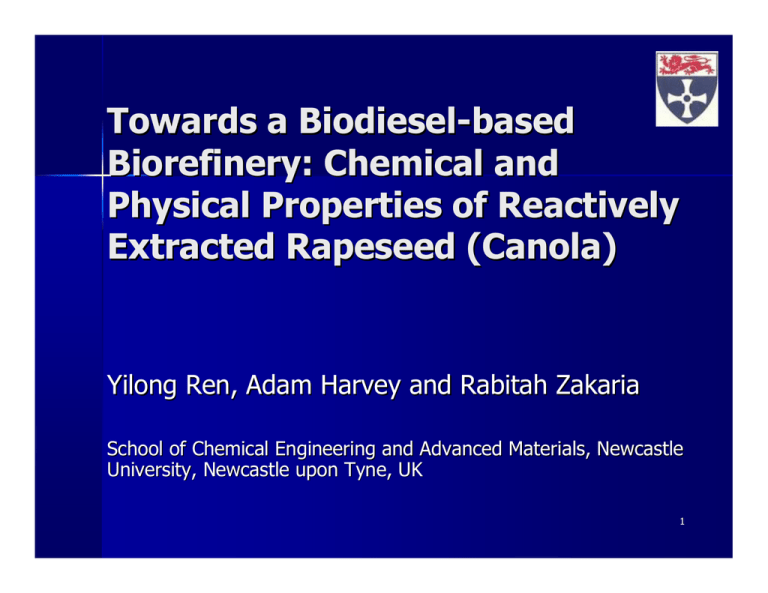Towards a Biodiesel - based Biorefinery: Chemical and
advertisement

Towards a Biodiesel-based Biorefinery: Chemical and Physical Properties of Reactively Extracted Rapeseed (Canola) Yilong Ren, Adam Harvey and Rabitah Zakaria School of Chemical Engineering and Advanced Materials, Newcastle University, Newcastle upon Tyne, UK 1 Contents 1. 2. 3. 4. 5. 6. 7. Overview of biodiesel production Comparison of conventional biodiesel production and reactive extraction Mass balance of reactive extraction Particle size effects reactive extraction Carbohydrate, lipid and protein contents of rapeseed particles in the reactive extraction Summary Acknowledgments 2 Overview Routes to biodiesel production from oils and fats: Base-catalyzed transesterification of the oil Direct acid-catalyzed transesterification of the oil Conversion of the oil to its fatty acids and then to biodiesel Enzyme –catalyzed of the oil Most of the biodiesel produced today use the base-catalyzed reaction for several reasons: It is low temperature and pressure It yields high conversion (98%) with minimal side reactions Lower reaction time It is a direct conversion to biodiesel with no intermediate compounds No exotic materials of construction are needed 3 Biodiesel Production: The Transesterification Reaction Triglyceride (Oil) COO HO CH2 COO CH COO CH2 + 3 CH OH 3 CH2 HO CH HO CH2 + COOCH3 Biodiesel (FAME) Catalyst (usually NaOH, KOH or NaOCH3) x3 Glycerol 4 Transesterification Reaction Sequence of Reactions Triglycerides + CH3OH ↔ Diglycerides +FAME Diglycerides + CH3OH ↔ Monoglycerides +FAME Monoglyceride + CH3OH ↔ Glycerol + FAME Typical process parameters (conventional transesterification): Molar ratio of TG:MeOH - 6:1 Catalyst Concentration – 0.5- 1 wt% oil Atmospheric Pressure Low Temperature 25 – 60oC 5 Biodiesel Production: From Oilseed to Final Product, Conventional Processing Whole seeds Drying Crushing: • capital and running cost intensive. • usually performed in very large, centralised plants (to achieve economies of scale) Maceration Hexane CRUSHING Solvent Extraction Meal Refining Transesterification Methanol + NaOH Purification Glycerol Waste water 6 Biodiesel Biodiesel Production: Reactive Extraction Whole seeds Drying Whole seeds Farm? Maceration Hexane Maceration CRUSHING Solvent Extraction Meal Refining Reactive Extraction Meal Transesterification Glycerol Methanol + NaOH Purification Biodiesel Waste water Methanol + NaOH Purification Glycerol Waste water 7 Biodiesel Reactive Extraction / In situ transesterification Biodiesel Production: From Oilseed to Final Product Whole seeds Reactive Extraction Benefits Reduced number of unit operations (Î reduced CapEx) Eliminate use of hexane Reduction in production cost? Potential for small-scale and local operation Maceration Reactive Extraction Methanol + NaOH Purification Meal Glycerol Waste water 8 Biodiesel Reactive Extraction / In situ transesterification Rape seed Cotyledon Carbohydrate (25%) (Cell wall) D-glucose, Dfructose, Dgalactose, sucrocose, raffinose, … Reactive Extraction-based Biodiesel Biorefinery Reactive Extraction Protein (2025%) Globulin albumin Lipids (4045%) Seed coat Lignin polyccarides Antioxdate compounds water MeOH/NaOH Settling washing Clean BD 45% TG? 45%? Seed cake Carbohydrate 44% Protein 56% phenolics 10%? Glycerol rich phase Dirty water 9 Effect of by particle size Time Mass of ester phase Yield 300-500 µm 20g 1 hour 9.9g 86.2(±5.3)% 500-850µm 20g 1 hour 7.5g 65.2(±6.2)% 10001400µm 20g 1hour 4.9g 43(±7.1)% Particle size Total weight 10 Effect of the reactive extraction on carbohydrate and lipid contents: 300-500µm particles size (before and after 1 hour reactive extraction of biodiesel) 11 SEM (before and after oil extraction 300-500µm) Cotyledon before Cotyledon after 12 Seed coat before Seed coat after Microscopy (periodic acid Shiff reaction PAS, before and after oil extraction, 300-500µm) Cotyledon before Cotyledon after 13 Seed coat before Seed coat after Microscopy staining with Sudan black B, Before and after oil extraction, 300-500µm Cotyledon before Cotyledon after 14 Seed coat before Seed coat after Effect of the reactive extraction on carbohydrate and lipid contents: 1-1.4mm particles (before and after 1 hour reactive extraction) 15 SEM (before and after reactive extraction, 11.4cm) Cotyledon before Cotyledon after 16 Microscopy (staining with periodic acid Shiff regent PAS, before and after extraction, 1-1.4cm) Cotyledon before Cotyledon after 17 Microscopy (Staining with Sudan black B, Before and after oil extraction, 1-1.4cm) Cotyledon before Cotyledon after 18 Protein concentration analysis of rapeseed particles before and after biodiesel production After oil removal however, almost half of the waste (seedcake/meal) mass ends up with a protein content of about 50%. This is mostly used in animal feed but, researchers say this could be "a source of new food ingredients" with potential functional and health properties. Using rapeseed protein as ingredients in experimental sausages boosted taste and aroma of the finished products, as scientists continue the search for novel functional ingredients. (Yumiko Yoshie-Stark from Tokyo University, and Fraunhofer Institute for Process Engineering and Packaging, Freising, Germany) 19 Rapeseed protein extraction (Sigma, plant total protein extraction kit) 1. Grind 10-250 mg -20 °C 2. Methanol removes the phenolics and tannins (remove the supernatant) 4. Plant protein extraction reagent 25 °C 5. Collect the supernatant as the total protein sample. -20 °C 3. Acetone removes the lipids (remove the supernatant) 20 Bradford method analyses the total protein concentration (spectrophotometer) Sample Before RE Methanol (only) Hexane Protein concentration (mg/ml) 7.59±0.62 6.38±0.86 6.67±0.92 7.26±0.43 21 Conclusions All the lipids were removed from 300-500µm cotyledon particles after 1 hour reactive extraction. However, in particle size range 11.4mm, some lipids still remain in the centre of the particles. This result agrees with respectively yields. There is no lipids in the seed coat. The carbohydrate is not affected by the reactive extraction (cotyledon and seed coat) at 300-500µm and 1-1.4mm. It is therefore possible to extracted this from seed cake. Protein contents of seedcake does not have significant affected by reactive extraction as well. Generally, antioxidant compounds are found in most seed coats, for example, Almond seed. This research shows that chemical contents in rapeseed’s seed coat are not affected during reactive extraction of biodiesel. Therefore, the antioxidant components can also be extracted from the seed cake. 22 Acknowledgements EPSRC research: Adaptive Processing of Natural Feedstocks Process intensification group members in the School of Chemical Engineering and Advanced Materials , Newcastle University Collaborators: University of Warwick, Bath University, Leeds University 23







